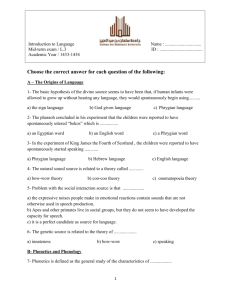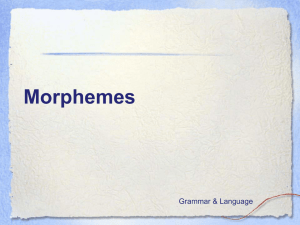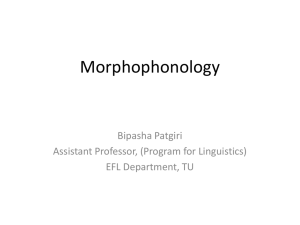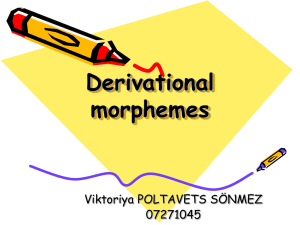Introduction to morphemes
advertisement
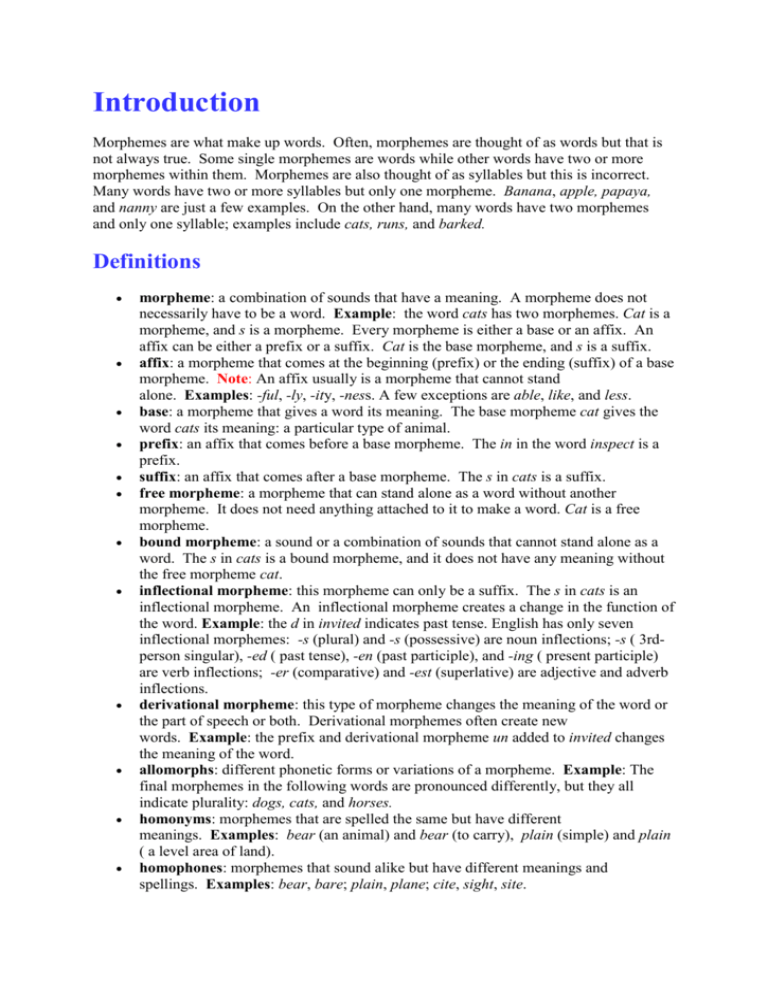
Introduction Morphemes are what make up words. Often, morphemes are thought of as words but that is not always true. Some single morphemes are words while other words have two or more morphemes within them. Morphemes are also thought of as syllables but this is incorrect. Many words have two or more syllables but only one morpheme. Banana, apple, papaya, and nanny are just a few examples. On the other hand, many words have two morphemes and only one syllable; examples include cats, runs, and barked. Definitions morpheme: a combination of sounds that have a meaning. A morpheme does not necessarily have to be a word. Example: the word cats has two morphemes. Cat is a morpheme, and s is a morpheme. Every morpheme is either a base or an affix. An affix can be either a prefix or a suffix. Cat is the base morpheme, and s is a suffix. affix: a morpheme that comes at the beginning (prefix) or the ending (suffix) of a base morpheme. Note: An affix usually is a morpheme that cannot stand alone. Examples: -ful, -ly, -ity, -ness. A few exceptions are able, like, and less. base: a morpheme that gives a word its meaning. The base morpheme cat gives the word cats its meaning: a particular type of animal. prefix: an affix that comes before a base morpheme. The in in the word inspect is a prefix. suffix: an affix that comes after a base morpheme. The s in cats is a suffix. free morpheme: a morpheme that can stand alone as a word without another morpheme. It does not need anything attached to it to make a word. Cat is a free morpheme. bound morpheme: a sound or a combination of sounds that cannot stand alone as a word. The s in cats is a bound morpheme, and it does not have any meaning without the free morpheme cat. inflectional morpheme: this morpheme can only be a suffix. The s in cats is an inflectional morpheme. An inflectional morpheme creates a change in the function of the word. Example: the d in invited indicates past tense. English has only seven inflectional morphemes: -s (plural) and -s (possessive) are noun inflections; -s ( 3rdperson singular), -ed ( past tense), -en (past participle), and -ing ( present participle) are verb inflections; -er (comparative) and -est (superlative) are adjective and adverb inflections. derivational morpheme: this type of morpheme changes the meaning of the word or the part of speech or both. Derivational morphemes often create new words. Example: the prefix and derivational morpheme un added to invited changes the meaning of the word. allomorphs: different phonetic forms or variations of a morpheme. Example: The final morphemes in the following words are pronounced differently, but they all indicate plurality: dogs, cats, and horses. homonyms: morphemes that are spelled the same but have different meanings. Examples: bear (an animal) and bear (to carry), plain (simple) and plain ( a level area of land). homophones: morphemes that sound alike but have different meanings and spellings. Examples: bear, bare; plain, plane; cite, sight, site. Fifteen Common Prefixes The following tables and tip are adopted from Grammar and Composition by Mary Beth Bauer, et al. Prefix Meaning ad- to, toward circum- around, about com- with, together de- away from, off dis- away, apart ex- from, out in- not in- in, into inter- between mis- wrong post- after re- back, again sub- beneath, under trans- across un- not Ten Common Suffixes Suffix Meaning -able (-ible) capable of being -ance (-ence) the act of -ate making or applying -ful full of -ity the state of being -less without -ly in a certain way -ment the result of being -ness the state of being -tion (-ion, -sion) the act of or the state of being Tip Suffixes can also be used to tell the part of speech of a word. The following examples show the parts of speech indicated by the suffixes in the chart. Nouns: -ance, -ful, -ity, -ment, -ness, -tion Verb: -ate Adjectives: -able, -ful, -less, -ly Adverb: -ly Exercises Identify and label the parts of the following words as: bound or free, derivational or inflectional, and base or affix. Indicate the number of morphemes in each word. 1. 2. 3. 4. 5. 6. 7. 8. dogs replay carrot inescapable television tenacity captivate unlikely Identify at least 10 sets of homophones and give the different meanings. Example: board (a flat piece of wood) and bored (uninterested, weary). Click here for answers. Bibliography Fromkin, Victoria, and Robert Rodman. An Introduction to Language. 5th ed. Fort Worth: Harcourt Brace Joanovich College Publishers, 1993. Kolln, Martha, and Robert Funk. Understanding English Grammar. 5th ed. Boston: Allyn and Bacon, 1998. Hacker, Diana. The Bedford Handbook for Writers. 3rd ed. Boston: Bedford Books of St. Martin's Press, 1991. Bauer, Mary Beth, et al., Grammar and Composition. New Jersey: Prentice-Hall, Inc., 1982. Written by Kirsten Mills Edited by Mark Canada, Ph.D.

